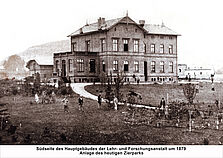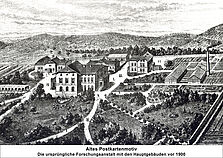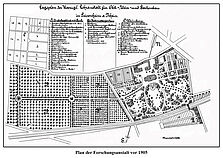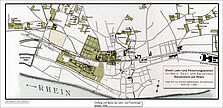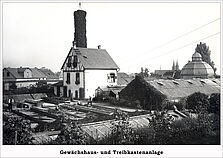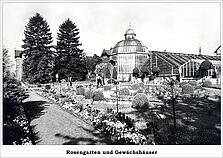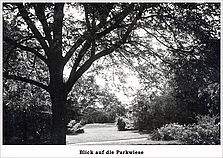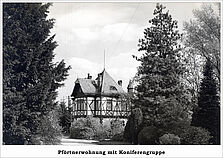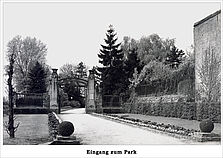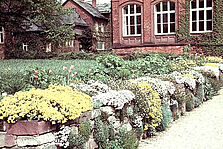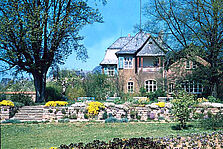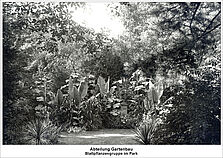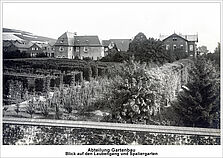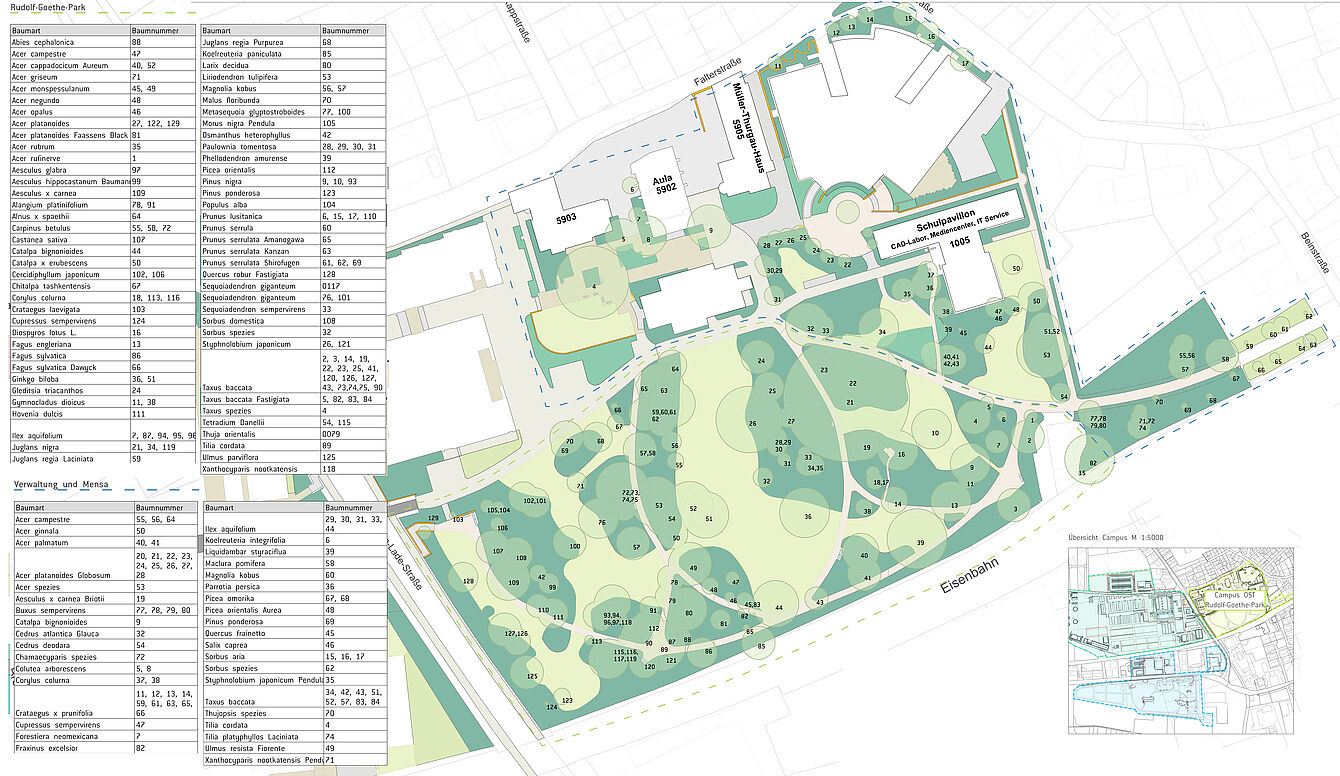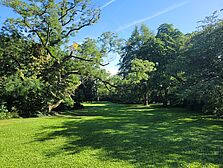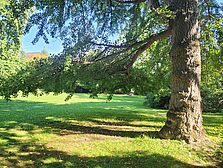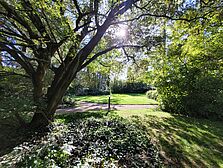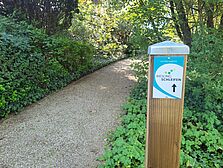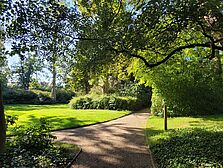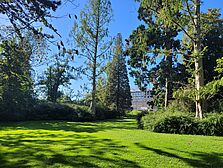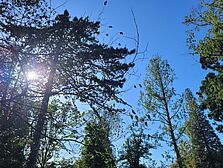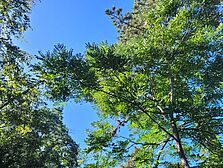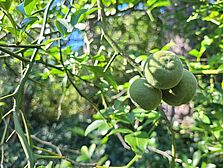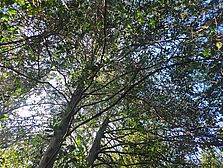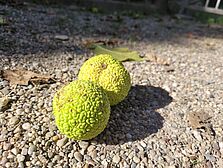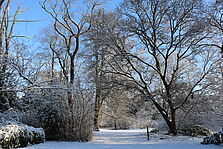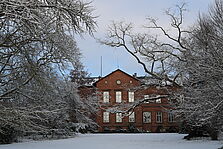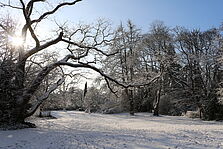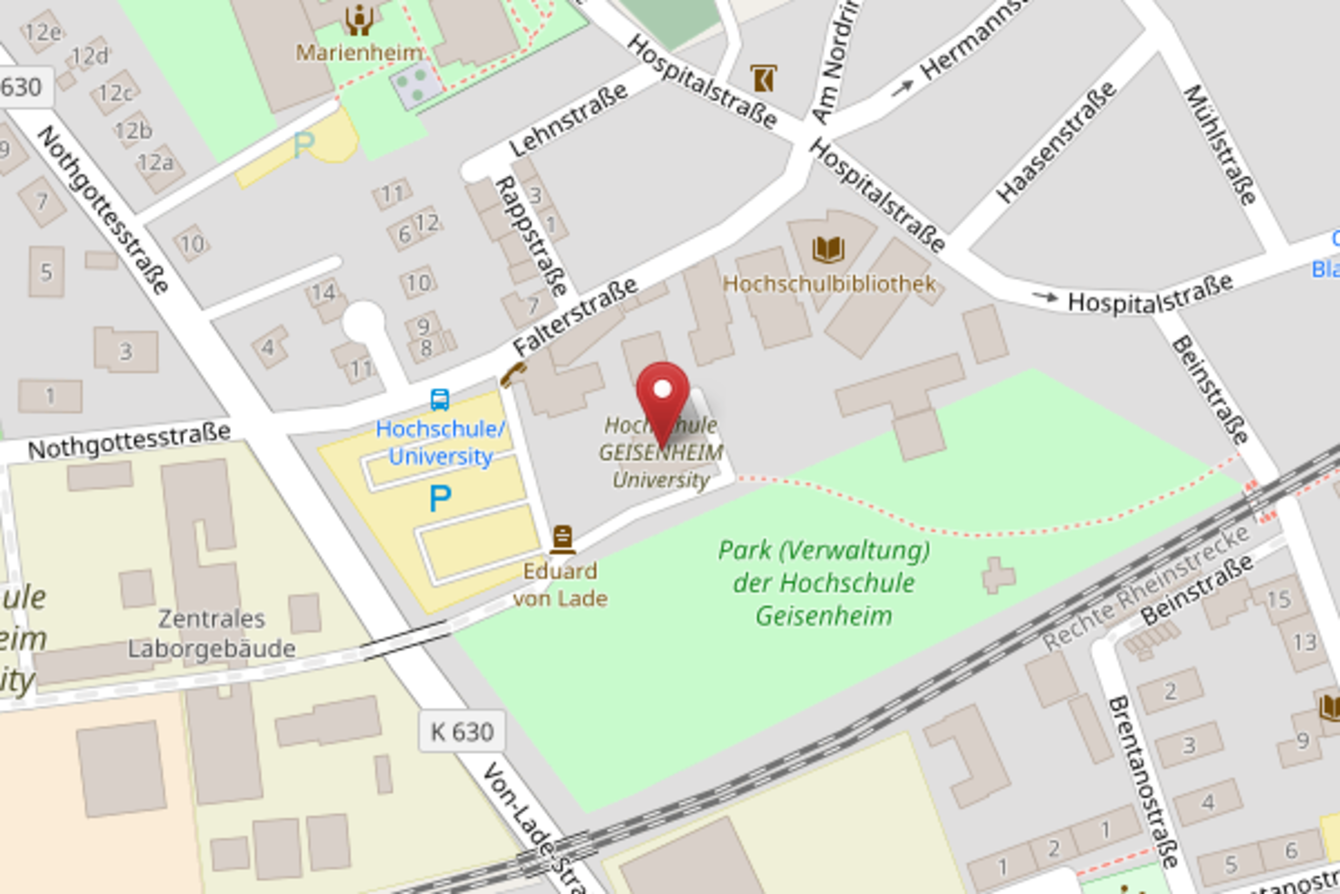Park of the Geisenheim Research Institute
The Rudolf Goethe Park, with its approximately 3 hectares, offers a wide range of exotic trees and rustic green spaces. Students, employees and visitors to the university campus have the opportunity to take a break in the publicly accessible park or take a walk along the curved paths at any time. The park is often used for festivals and graduation ceremonies at the university and the diverse and special plant population is actively integrated into teaching.
Some very old trees such as the old string tree (Styphnolobium japonicum) on the festival meadow, large ginkgo trees (Ginkgo biloba) and the impressive black walnut (Juglas nigra) probably come from the original complex.
The history of Rudolf-Goethe-Parks
The creation of today's Rudolf Goethe Park is directly related to the founding of Geisenheim University. When Eduard von Lade founded the Royal Training Institute for Fruit and Viticulture in 1872, a 2-hectare fruit park was created at the same time. Although the park's fruit trees were sorted schematically, they were arranged in groups to create an attractive picture. Rumor has it that the park was designed by the Siesmayer brothers from Frankfurt am Main. However, this is not clearly proven historically.
This planned attractive image apparently did not materialize, because when Rudolf Goethe was appointed director of the educational institution in 1879, he not only restructured the teaching operations, but also the entire fruit park. According to reports, it was “unsightly” and “missed” its target. The new park was intended to be an ornamental park, so all fruit trees were relocated to a reduced orchard and over 200 deciduous and coniferous trees were planted in the park instead. This new landscape park contained the typical elements of the parks of that time such as hedges, pavilions, water basins, carpet beds, pergolas and avenues. But the aspect of teaching was also always relevant; the special trees in the park were given labels and used for teaching purposes. The center of the park was today's administration building, surrounded by a few other buildings and greenhouses. The new ornamental park developed well and became increasingly popular. The exotic and special selection of plants also received great attention.
At the beginning of the 20th century there were some changes and expansions, including the construction of several new buildings, including the auditorium. Descriptions from this time show that some of the trees that are still in the park were already impressive specimens at that time. For example, the large black walnut (Juglans nigra), which was already one of the largest trees in the inventory in the 1930s, was highlighted. The giant sequoia tree in the west of the park, the female ginkgo (Ginkgo biloba) on the main meadow in front of the administration, and the hanging string tree (Styphnolobium japonicum 'Pendula') at the pavilion are also already mentioned. Particularly highlighted is the picturesque overhanging cord tree (Styphnolobium japonicum) on the main meadow, which still creates a special atmosphere today.
During and after the Second World War there is little information about the trees and the park. Reports of major changes did not appear until the 1960s. In addition to the expansion measures on the campus area and general expansion of the infrastructure, there were also some interventions in the park. The densely overgrown trees had to be thinned out and some special trees had to be replanted in order to preserve the character of the park.
At the beginning of the 1970s, the park was reduced to the framework that still exists today through new entrance situations in the area of the buildings and through the parking lot in the west (today the construction site for the new lecture hall building) and new lecture hall buildings. The main entrance, which previously led through the park, is now from Falterstrasse in the north. The underpass and the construction of the bridge to the western part of the university campus also date from this time. The extensive construction work resulted in major interventions in the tree population. This was used by Prof. Däumel, the director of the institute for landscaping, to carry out comprehensive tree inventories in the mid-1970s. But in 1978, Däumel left the institute, which was then unoccupied for 10 years. The park's responsibilities were divided. During this time there were hardly any changes or measures in the park.
Only under the leadership of Prof. Dr. Hey, which began in 1988, major clearing measures and new tree plantings took place in the early 1990s after various storm events. Many trees that were lost were also weakened or had diseases. Hey has already linked these major outages to the effects of a changing climate.
Due to personnel restructuring, many of the intensively maintained ornamental beds disappeared during this time.
In the course of the research institute's 125th anniversary in 1997, in addition to some structural measures and redesigns, further tree renovations took place. As part of the construction of the underpass on Beinstrasse, the entrance to the park was redesigned in 2001. The small tree avenue that lines the side entrance dates from this time. Once again, the responsibility for park maintenance was divided between different institutes and maintenance measures did not follow a common concept. Interventions in the tree population were mostly necessary for reasons of traffic safety. Among other things, some rare trees such as a Pyrenean oak (Quercus pyrenaica) and an orange cherry (Idesia polycarpa) were felled here.
In recent decades, tree damage due to drought and pest infestation has increased. Many failures and damage occur in coniferous trees. A connection with the changing climate can be seen.
Today's park is an important garden monument and is a listed building. The future of the park will be a challenge that deals with the demands of monument protection, the preservation of endangered existing trees in the face of climate change and the appropriate selection and care of new trees.
It is important to preserve the basic idea of diversity, specialness and teaching, which is still recognizable today and which has characterized the Rudolph Goethe Park from the beginning.
Source, all sections: Freely summarized based on the extensive research work by Marie-Louise Faber from her master's thesis "Trees in historical parks in climate change using the example of the university parks of the Geisenheim University" from 2020 (can be viewed in the library of the Geisenheim University)
Rudolf Goethe was an oenologist and pomologist who was born in Saxony-Anhalt on April 13, 1843 and died in Darmstadt in 1911.
Goethe studied at the Pomological Institute in Reutlingen and trained in landscape gardening in Bad Muskau. He managed and developed a tree nursery in Cannstatt and was director of the imperial fruit and horticultural school in Brumath near Grafenburg in Alsace. As the last stop in his career until his retirement, he headed the viticulture and horticulture college in Geisenheim from 1879 to 1903.
In addition to his focus on fruit and wine growing, Goethe was very interested in gardening and did his own planning. His family is actually said to be distantly related to Johan Wolfgang von Goethe.

